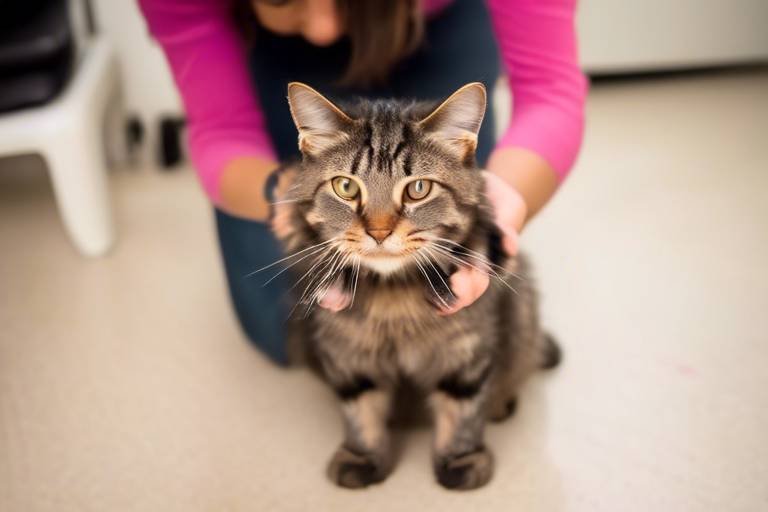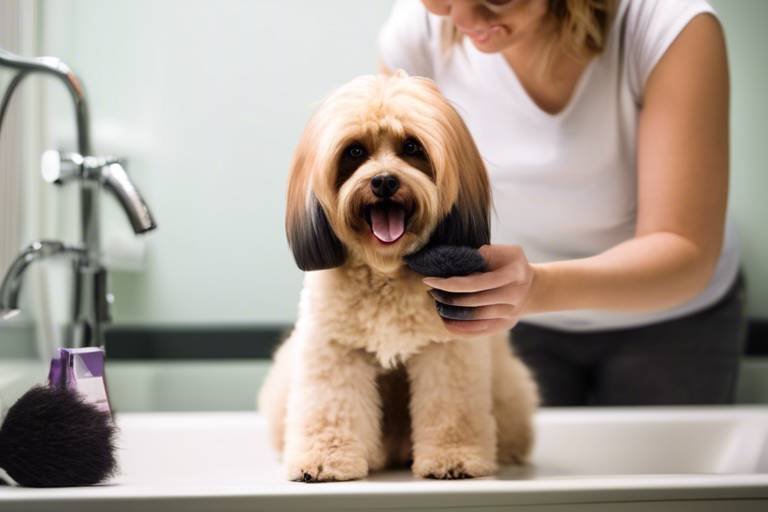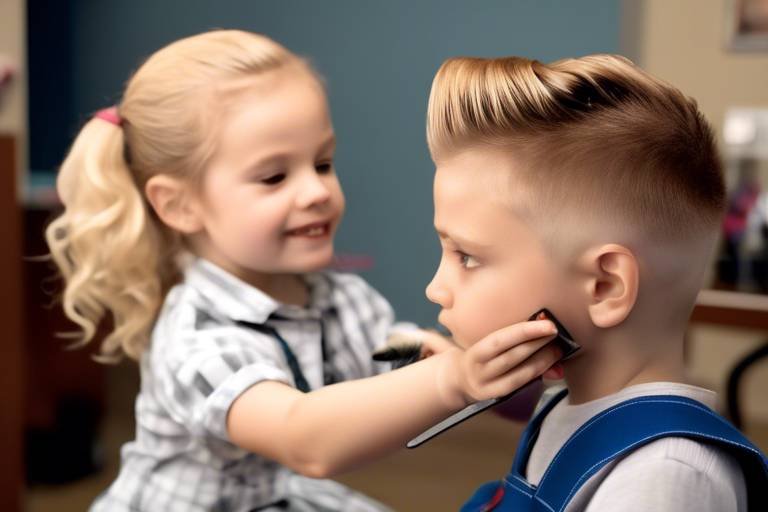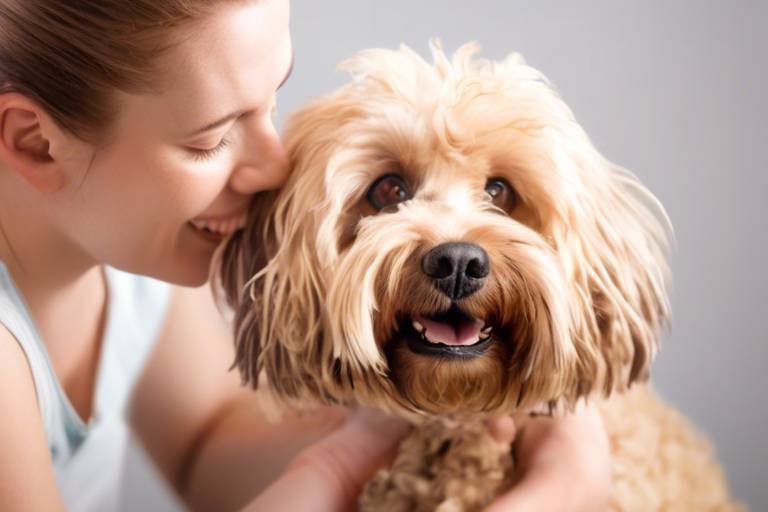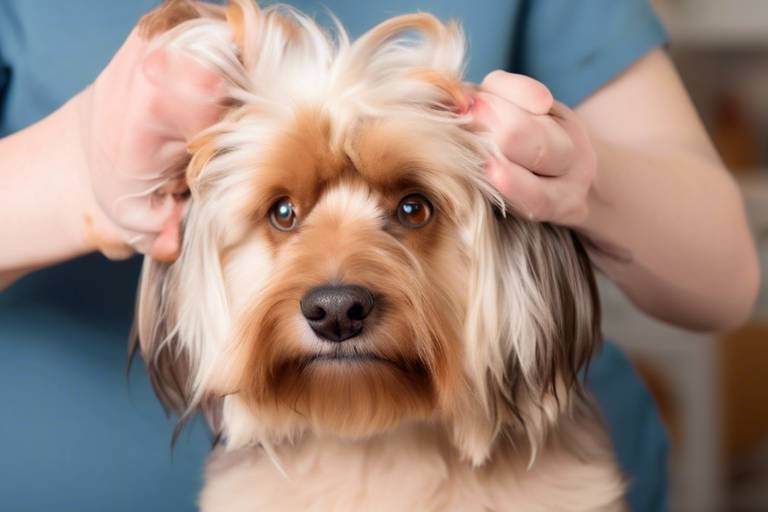How to Train Your Cat to Accept Regular Grooming
Grooming your cat can often feel like a battle of wills. You want your feline friend to look and feel their best, but they might see grooming as an invasion of their personal space. The good news is that with a little patience and the right techniques, you can train your cat to not only accept grooming but actually enjoy it! Imagine transforming those dreaded grooming sessions into bonding moments filled with purrs and headbutts. In this article, we'll explore effective strategies and tips that make the grooming process easier for both you and your furry companion.
Before diving into the grooming tools and techniques, it's essential to understand your cat's behavior. Cats are creatures of habit and can be quite sensitive to changes in their environment. Recognizing their body language is crucial; for example, a flicking tail or flattened ears might indicate discomfort or irritation. By observing these signals, you can tailor your grooming approach to make the experience more enjoyable for your cat. Think of it as learning a new language—once you understand what your cat is saying, you can communicate more effectively and create a positive grooming experience.
Selecting the appropriate grooming tools is essential for your cat's comfort and safety. Just like humans have different hair types and styles, cats do too! Using the right tools can enhance the grooming experience and prevent any unnecessary discomfort. It's important to know that different tools serve various purposes, so let’s break it down.
There are several types of brushes available, each designed for specific coat types. For instance, if your cat has a short coat, a simple bristle brush may suffice. However, if you have a long-haired beauty, a slicker brush or a wide-toothed comb would be more appropriate. Choosing the right brush can prevent discomfort and reduce shedding, making your cat feel pampered rather than tormented.
Deshedding tools are a game changer, especially for long-haired cats that require more maintenance. These tools help reduce loose fur and prevent mats, which can be painful for your cat. Think of it as giving your cat a spa day—who wouldn’t want that?
Combs and rakes are beneficial for detangling and removing debris from your cat's fur. Using them correctly can help keep your cat's coat healthy and shiny. Always remember to be gentle; cats appreciate a soft touch just like we do!
Now that you have the right tools, let's talk about the techniques. Employing the right grooming techniques can make the process more enjoyable for your cat. Gentle strokes and positive reinforcement are key elements to consider. Think of grooming as a soothing massage for your cat—slow, gentle movements will help them relax and even enjoy the process.
Creating a consistent grooming schedule helps your cat become accustomed to the process. Just like humans thrive on routine, so do cats. Regular sessions can make grooming feel like a normal part of their day. Try to set aside a specific time each week for grooming; your cat will start to anticipate it, and it will become less of a chore and more of a bonding experience.
Choosing a quiet, comfortable location for grooming can significantly reduce stress for your cat. Think about it—would you want to be groomed in a noisy, chaotic environment? Consistency in timing also helps them anticipate grooming sessions, making them feel more secure.
Introducing grooming gradually can help your cat adjust to the process. Start with short sessions—just a few minutes at first—and slowly increase the duration as they become more comfortable. This gradual approach can prevent overwhelming your cat, making it easier for them to accept grooming as a regular part of their routine.
Using positive reinforcement can encourage your cat to embrace grooming. Treats, praise, and playtime can create a more enjoyable experience and build trust. When your cat associates grooming with positive outcomes, they are more likely to accept it without fuss.
Incorporating treats during grooming can motivate your cat to stay calm. Timing the treats correctly is essential for reinforcing positive behavior. For example, give a treat right after a successful grooming session or when your cat stays still. This creates a positive association with grooming in their mind.
A calm and loving environment can significantly impact your cat's grooming experience. Reducing distractions and providing comfort can help ease their anxiety. Consider playing soft music or using calming scents to create a soothing atmosphere.
Observing your cat's reactions during grooming sessions is crucial. Understanding their comfort levels will help you adjust your approach and ensure a positive experience. Pay attention to their body language and vocalizations; these cues will guide your grooming strategy.
Identifying signs of stress in your cat can help you make necessary adjustments. Watch for behaviors like hissing, trying to escape, or excessive grooming. If you notice these signs, take a step back and reassess your approach. It's all about being flexible and responsive to your cat's needs.
Being flexible with your grooming techniques based on your cat's response is important. Adapt your approach to their needs to foster a more positive grooming experience. Remember, every cat is different, and what works for one may not work for another. The key is to be patient and persistent!
- How often should I groom my cat? It depends on the breed and coat type. Long-haired cats may need grooming several times a week, while short-haired cats might only need it once a month.
- What if my cat hates being groomed? Start slowly and gradually introduce grooming. Use treats and positive reinforcement to create a more enjoyable experience.
- Can grooming help with shedding? Yes! Regular grooming can significantly reduce shedding and help keep your home cleaner.
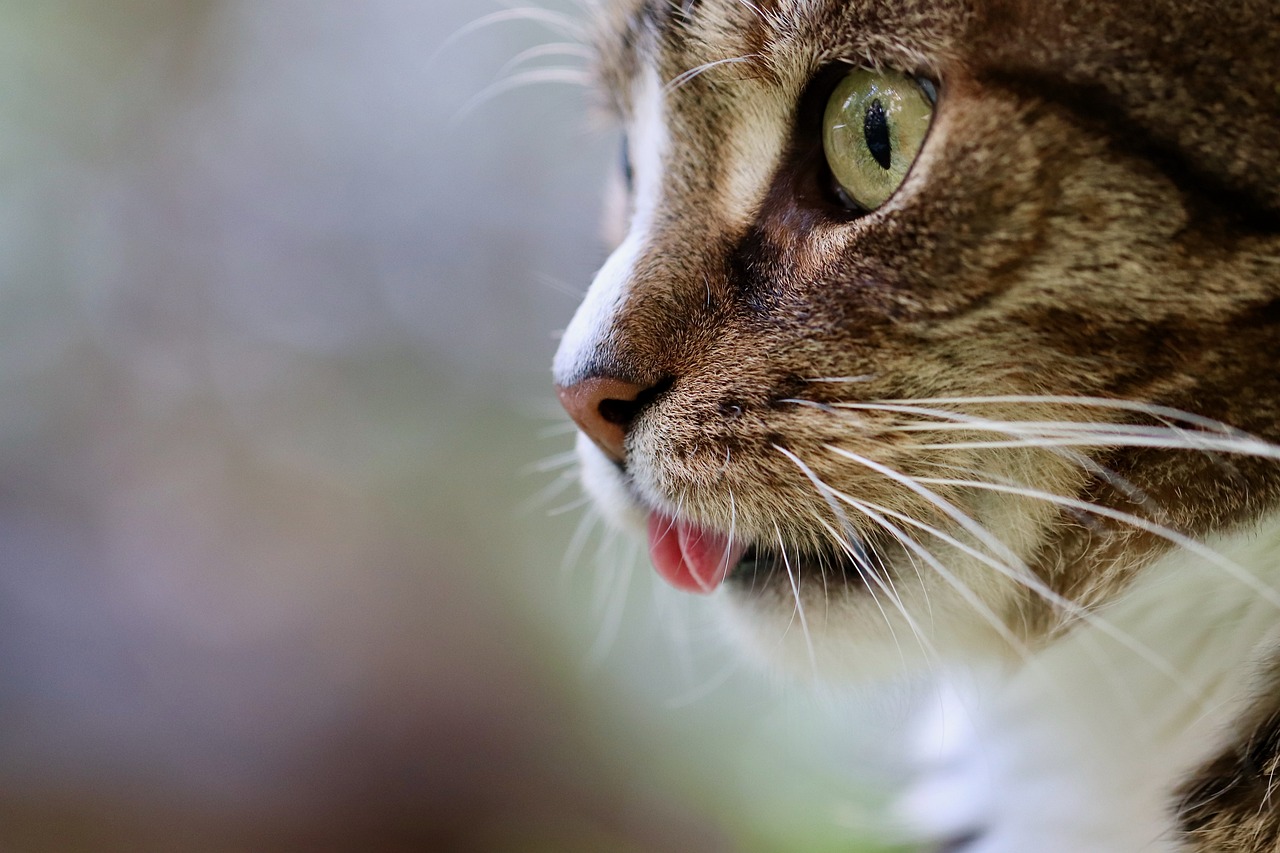
Understanding Your Cat's Behavior
Understanding your cat's behavior is crucial for creating a positive grooming experience. Cats are unique creatures with their own set of instincts and preferences. By recognizing their natural tendencies, you can tailor your grooming approach to make it more enjoyable for both you and your feline friend. For instance, did you know that a cat's body language can tell you a lot about how they feel during grooming? A relaxed cat will often purr, knead their paws, and have their tail held high, while a tense cat may flatten their ears, swat, or try to escape. Paying attention to these signals can help you gauge their comfort level.
Moreover, cats are creatures of habit. They thrive on routine and predictability. If you can establish a consistent grooming schedule, your cat is likely to become more accustomed to the process over time. This means choosing a time of day when your cat is naturally more relaxed, such as after a meal or playtime, can set the stage for a successful grooming session. Remember, the goal is to make grooming feel like a normal part of their day rather than a chore.
Another important aspect to consider is the environment in which you groom your cat. A quiet, comfortable space can significantly reduce stress. Cats are sensitive to their surroundings, and a noisy or chaotic environment can make them anxious. Setting up a designated grooming area where your cat feels safe and secure can enhance their overall experience. You might even want to add a cozy blanket or their favorite toy to the space to make it more inviting.
To further understand your cat's behavior, it can be helpful to familiarize yourself with common signs of comfort and discomfort during grooming. Here’s a quick reference table:
| Behavior | Indication |
|---|---|
| Purring | Contentment |
| Tail held high | Feeling safe and happy |
| Flattened ears | Feeling threatened or annoyed |
| Attempting to escape | Discomfort or fear |
By observing these behaviors, you can make necessary adjustments to your grooming techniques. If your cat seems stressed, it’s essential to pause and reassess your approach. Maybe they need a break, or perhaps you need to switch to a gentler tool. Remember, grooming should be a bonding experience, not a battleground!
In conclusion, understanding your cat's behavior is the first step toward successful grooming. By paying attention to their body language and establishing a routine in a comfortable environment, you can turn grooming from a dreaded task into a pleasant activity that strengthens your bond with your furry companion.
- How often should I groom my cat? It depends on the breed and coat type. Long-haired cats may need grooming several times a week, while short-haired cats can usually be groomed less frequently.
- What if my cat hates being groomed? Start slowly and use positive reinforcement techniques. Gradually introduce grooming and always pay attention to their comfort levels.
- Can grooming help reduce shedding? Yes, regular grooming can help remove loose fur and reduce shedding in your home.
- What tools should I use for grooming? The tools depend on your cat's coat type. Brushes, combs, and deshedding tools each serve different purposes.
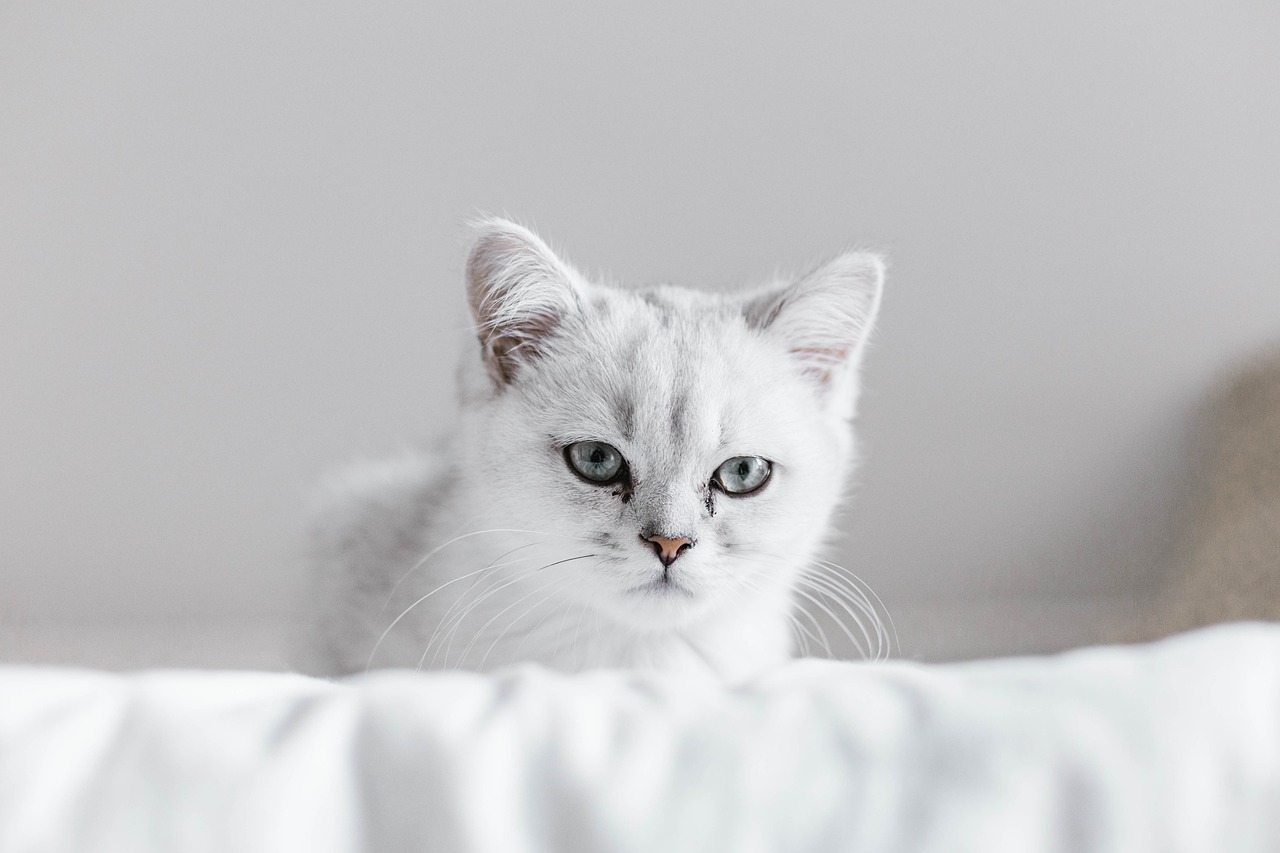
Choosing the Right Grooming Tools
When it comes to grooming your feline friend, choosing the right tools is essential for ensuring a smooth and enjoyable experience for both you and your cat. Just like how a chef needs the right knives to prepare a delicious meal, you need the proper grooming tools to keep your cat's coat healthy and shiny. The right tools not only make the job easier but also help prevent discomfort and stress for your pet. So, let’s dive into the various grooming tools available and how to select the best ones for your furry companion!
First off, it's important to consider the type of coat your cat has. Is it long, short, curly, or straight? Each coat type requires specific tools to keep it looking its best. For instance, long-haired cats often need more frequent grooming to prevent mats and tangles, while short-haired cats might require less maintenance. Here’s a quick breakdown of the tools you might need based on coat type:
| Coat Type | Recommended Tools |
|---|---|
| Long-haired | Deshedding tools, wide-toothed combs, slicker brushes |
| Short-haired | Bristle brushes, rubber grooming gloves |
| Curly | Coarse combs, detangling sprays |
| Straight | Standard brushes, rakes |
Next, let’s talk about the types of brushes you might consider. Each brush serves a different purpose, and using the wrong one can lead to discomfort for your cat. For example, a slicker brush is fantastic for removing loose fur and mats, particularly in long-haired breeds. On the other hand, a bristle brush works wonders for short-haired cats, as it helps distribute natural oils and keeps their coat shiny. It’s like choosing the right outfit for an occasion; the right brush can make all the difference!
Additionally, deshedding tools are a must-have if your cat sheds a lot. These tools are designed specifically to remove loose fur without pulling on the skin, making them a favorite among cat owners. Think of them as a magic wand that makes shedding less of a chore. For those stubborn mats, a comb or rake can be incredibly beneficial. They help detangle knots and remove debris, ensuring your cat’s coat stays healthy and free from any unpleasant surprises.
Now, while grooming tools are important, the way you use them matters just as much. Always ensure that the tools are clean and in good condition. A rusty comb or a worn-out brush can irritate your cat’s skin and make grooming a negative experience. Regularly inspect your tools and replace them as needed to keep your grooming sessions enjoyable.
In conclusion, selecting the right grooming tools is a crucial step in making grooming a positive experience for your cat. By understanding your cat’s coat type and choosing appropriate tools, you can significantly reduce stress and enhance comfort during grooming sessions. Remember, grooming isn’t just about keeping your cat looking good; it’s also about bonding with your furry friend and ensuring their overall well-being!
Types of Brushes
When it comes to grooming your feline companion, the type of brush you choose can make all the difference. Just like humans have different hair types, cats have varying coat textures that require specific grooming tools to keep them looking their best. Understanding these differences is crucial for a successful grooming routine. Let's explore some of the most common types of brushes and their benefits.
First off, we have bristle brushes. These brushes are ideal for short-haired cats and work wonders for distributing natural oils throughout their fur, giving it that shiny, healthy look. The bristles are gentle on the skin, making them a favorite for many cat owners. If your cat has a sleek coat, a bristle brush can be a game-changer, helping to reduce shedding while keeping your kitty comfortable.
For those with medium to long-haired cats, slicker brushes are a must-have. These brushes have fine, short wires close together, which are perfect for removing mats and tangles. If you've ever tried to untangle a stubborn knot in your cat's fur, you know how challenging that can be! A slicker brush can help you tackle those tough spots with ease. Just remember to be gentle to avoid hurting your cat's skin.
Another fantastic option is the rubber brush. These brushes are excellent for cats that are sensitive to traditional bristles. The rubber bristles massage your cat's skin while effectively removing loose hair and dirt. Plus, they can be used during bath time to help lather shampoo. It's like giving your cat a spa day right in your home!
Now, let’s not forget about deshedding tools, which are specifically designed for cats that shed a lot. These tools can significantly reduce loose fur and prevent mats from forming, especially in long-haired breeds. They often feature a blade that gently removes the undercoat without damaging the top layer of fur. If you've ever found yourself covered in cat hair, a deshedding tool might just be your new best friend!
Lastly, we have combs and rakes. These tools are fantastic for detangling and removing debris from your cat's fur. Combs can help with finer detangling, while rakes are great for tackling larger mats. Using these tools in conjunction with brushes can create a comprehensive grooming routine that leaves your cat looking fabulous.
In summary, selecting the right brush for your cat is essential for a smooth grooming experience. Each type of brush serves a unique purpose, and understanding your cat's coat type will help you choose the best option. Always keep your cat's comfort in mind, and don't hesitate to experiment with different tools to find what works best for both of you!
- How often should I groom my cat?
It depends on the breed and coat type. Long-haired cats may need grooming several times a week, while short-haired cats can often be groomed once a week. - What if my cat doesn't like being groomed?
Start slowly and use positive reinforcement. Gradually introduce grooming sessions and make them a positive experience with treats and praise. - Can I use human brushes on my cat?
It's best to use brushes specifically designed for cats, as human brushes may not be suitable for their skin and fur type. - What should I do if I encounter mats?
Use a slicker brush or a deshedding tool to gently work through the mats. If they are severe, consider consulting a professional groomer.
Deshedding Tools
When it comes to grooming your cat, are a game changer, especially for those long-haired furballs that seem to shed like a mini snowstorm in your living room. These tools aren't just about keeping your home fur-free; they're essential for maintaining your cat's coat health and preventing pesky mats. Imagine trying to untangle a ball of yarn—frustrating, right? That's how your cat feels when their fur gets matted. Using the right deshedding tool can make all the difference!
There are several types of deshedding tools available, each designed to cater to different coat types and shedding needs. For instance, a deshedding brush typically features fine teeth that reach deep into the undercoat, effectively removing loose fur without damaging the top layer. This tool is particularly beneficial for cats with thick or double coats, as it helps to reduce the amount of fur that ends up on your furniture and clothes.
Another popular option is the rubber grooming mitt. This tool not only helps in deshedding but also provides a gentle massage that your cat will likely enjoy. Cats are naturally inclined to love being petted, and using a rubber mitt can turn grooming into a bonding experience. You'll find that many cats will start to associate grooming with positive feelings, especially when you incorporate treats and praise into the routine.
When selecting a deshedding tool, consider the following factors:
- Coat Type: Long-haired cats benefit from tools designed to reach the undercoat, while short-haired cats may require less intensive grooming.
- Comfort: Ensure the tool is comfortable for both you and your cat. A good grip and ergonomic design can make grooming sessions less tiring.
- Ease of Cleaning: Look for tools that are easy to clean to maintain hygiene and efficiency.
Incorporating deshedding tools into your grooming routine not only helps to control shedding but also promotes a healthier coat. Regular use can reduce the risk of hairballs, which can be a significant issue for many cats. Plus, it allows you to check for any skin issues or parasites that might be lurking beneath the fur. So, grab that deshedding tool and get ready to transform grooming from a chore into a delightful experience for both you and your feline friend!
Q: How often should I use deshedding tools on my cat?
A: It depends on your cat's coat type. Long-haired cats may need deshedding sessions 2-3 times a week, while short-haired cats might only need it once a week.
Q: Can I use human brushes on my cat?
A: It's best to use brushes specifically designed for cats, as human brushes may not be gentle enough for their sensitive skin.
Q: What if my cat doesn't like being groomed?
A: Start slowly and use positive reinforcement techniques. Gradually introduce grooming sessions and reward your cat with treats and praise to create a positive association.
Combs and Rakes
When it comes to grooming your feline friend, play a pivotal role in maintaining their coat health. These tools are particularly effective for detangling fur and removing debris, ensuring that your cat's coat remains shiny and free from mats. Imagine trying to untangle a ball of yarn – that’s how your cat feels when their fur gets knotted. Using the right grooming tools can turn a frustrating experience into a soothing one for both you and your cat.
Combs, designed with fine teeth, are excellent for reaching the undercoat and removing loose hairs. They can also help in distributing natural oils throughout your cat's fur, which contributes to a healthy shine. However, it’s important to choose a comb that suits your cat's coat type. For instance, a wide-toothed comb is ideal for long-haired breeds, while a finer comb works wonders on short-haired cats. Rakes, on the other hand, are perfect for tackling mats and tangles, especially in thicker coats. They have sturdy, spaced-out teeth that can penetrate deep into the fur without pulling on the skin, making them a favorite for many cat owners.
To make the most of these grooming tools, consider the following tips:
- Choose the Right Tool: Always select a comb or rake that matches your cat's coat type to avoid discomfort.
- Gentle Approach: Use a gentle hand when combing or raking. Start from the tips of the fur and work your way up to the roots to prevent pulling.
- Stay Calm: Your cat can sense your emotions. Maintain a calm demeanor to help them feel at ease during grooming.
Incorporating combs and rakes into your grooming routine can significantly enhance your cat's comfort and enjoyment. Regular grooming not only prevents mats and tangles but also serves as a bonding experience between you and your furry companion. Just like a soothing massage, grooming can be a delightful experience for your cat when done right. So, grab those combs and rakes, and let the grooming begin!
Here are some common questions that cat owners have regarding grooming with combs and rakes:
- How often should I groom my cat? It depends on the breed and coat type. Long-haired cats may need daily grooming, while short-haired cats can be groomed weekly.
- Can I use human combs on my cat? It's best to use tools specifically designed for cats to avoid causing discomfort or injury.
- What if my cat doesn't like being groomed? Gradually introduce grooming sessions and use positive reinforcement to help your cat associate grooming with pleasant experiences.
Grooming Techniques
When it comes to grooming your feline friend, the technique you use can make a world of difference. Cats are known for their independent and sometimes finicky nature, so it’s essential to approach grooming with care and consideration. One of the most effective techniques is to use gentle strokes while brushing. Think of it like petting your cat; you wouldn’t want to be too rough, right? The goal is to create a soothing experience that your cat associates with comfort and affection.
Incorporating positive reinforcement into your grooming sessions can also work wonders. This means rewarding your cat with treats or praise whenever they stay calm or allow you to groom them. It’s like training a dog, but with a twist—cats respond well to rewards when they feel safe and appreciated. For instance, after a few gentle strokes with the brush, you might say, “Good kitty!” and offer a small treat. This builds a positive connection between grooming and pleasure, making your cat more likely to tolerate or even enjoy the process.
Another technique to consider is to establish a rhythm during grooming. Cats are creatures of habit, and they often find comfort in routine. Try to maintain a consistent motion as you brush—long, smooth strokes are usually best. You can even hum a little tune while you groom; this can help to create a calming atmosphere. If your cat seems to enjoy the rhythm, you might notice them purring, which is a great sign that they’re feeling relaxed.
Additionally, be mindful of the areas you groom. Cats can be quite sensitive about certain spots, such as their belly or tail. Start with less sensitive areas, like the back and sides, before gradually moving to other parts. If your cat shows signs of discomfort, such as twitching or trying to move away, it’s crucial to respect their boundaries. You can always return to those areas later when they’re more comfortable.
Lastly, consider using a combination of tools for a more effective grooming session. For example, you might start with a slicker brush to remove loose fur, followed by a comb to detangle any knots. This two-step approach not only helps in maintaining your cat’s coat but can also be a more enjoyable experience for them. Just remember to keep an eye on your cat’s reactions; if they seem stressed, take a break and try again later.
Here are some common questions that many cat owners have regarding grooming techniques:
- How often should I groom my cat? - It depends on the breed and length of their fur. Long-haired cats may require grooming several times a week, while short-haired cats can often be groomed less frequently.
- What if my cat hates being groomed? - Start slowly and use positive reinforcement to create a more enjoyable experience. Gradually introduce grooming sessions and take breaks as needed.
- Are there specific brushes for different coat types? - Yes, different brushes are designed for various coat types. It's essential to choose the right one to avoid discomfort and achieve the best results.

Establishing a Routine
Creating a consistent grooming routine is essential for helping your cat become accustomed to the process. Just like humans thrive on routine, our feline friends also appreciate predictability in their daily activities. By establishing a regular grooming schedule, you can transform what might initially seem like a chore into a comforting ritual that both you and your cat can look forward to. Imagine how much easier it would be if your cat understood that grooming time is simply part of their day, much like meal times or play sessions.
When setting up this routine, it's important to choose a specific time and place for grooming. Cats can be creatures of habit, so selecting a quiet, comfortable location in your home will help reduce any anxiety they might feel. Think of it as creating a little spa environment for your furry companion! This could be a cozy corner with their favorite blanket or a spot near a sunny window where they enjoy lounging. Consistency in timing is also crucial; try to groom your cat at the same time each day. This predictability allows them to anticipate the session and can even help them relax.
To help your cat adjust to this new routine, consider starting with short grooming sessions. Gradually increase the duration as they become more comfortable. For example, you might begin with just a few minutes of gentle brushing, then slowly extend it to 10 or 15 minutes as they get used to the sensation. This gradual introduction can prevent overwhelming your cat and can foster a sense of safety and trust.
Here’s a simple table to illustrate a potential grooming schedule:
| Day | Time | Duration |
|---|---|---|
| Monday | 3:00 PM | 5 minutes |
| Wednesday | 3:00 PM | 10 minutes |
| Friday | 3:00 PM | 15 minutes |
This table is just a starting point. Feel free to adjust according to your cat's comfort level and your schedule. The key is to remain flexible and attentive to your cat’s needs. If they seem stressed or agitated, it’s okay to shorten the session or take a break. Remember, the goal is to make grooming a positive experience, not a stressful one. With time, patience, and a little creativity, you’ll both find joy in these grooming sessions.
- How often should I groom my cat?
It depends on the breed and coat type. Long-haired cats may require grooming several times a week, while short-haired cats may only need it once a week. - What if my cat hates being groomed?
Start slowly and use positive reinforcement. Gradually introduce grooming in short sessions to help them adjust. - Are there specific tools I should use?
Yes, different brushes serve different purposes. Choose tools that match your cat's coat type for the best results.
Setting a Time and Place
When it comes to grooming your cat, timing and location can make all the difference in the world. Imagine trying to focus on a task in a chaotic environment—it's tough, right? Your cat feels the same way! By choosing a quiet and comfortable space for grooming, you create an atmosphere that helps your feline friend feel safe and relaxed. Think about areas in your home that are free from distractions, such as loud noises or bustling family members. A cozy corner on the couch or a quiet room can be perfect.
Consistency is another key factor. Cats thrive on routine, and establishing a regular grooming schedule can help them anticipate these sessions. Try to set a specific time each week when you can dedicate a few minutes to grooming. Whether it’s every Saturday morning or Wednesday evening, sticking to a schedule can help your cat feel more at ease. Consider the following points when setting a time:
- Choose a time when your cat is naturally calm, such as after a meal or a play session.
- Keep the grooming sessions short and sweet to start with, gradually increasing the duration as your cat becomes more comfortable.
- Be mindful of your cat's mood; if they seem restless or agitated, it might be best to postpone the session.
Additionally, the location should be free from any potential stressors. For example, if your cat is scared of the vacuum cleaner, avoid grooming them in the same room where it’s stored. You might also want to consider using a non-slippery surface like a mat or towel to help your cat feel secure during grooming. This small change can make a big difference in their comfort level.
In summary, by carefully selecting the right time and place for grooming, you can significantly improve your cat's experience. A calm environment combined with a consistent routine lays the groundwork for a successful grooming session, turning what might have been a dreaded chore into a bonding experience for both you and your furry companion.
- How often should I groom my cat? It depends on the breed and coat type. Long-haired cats may require grooming several times a week, while short-haired cats might only need it once a month.
- What if my cat doesn’t like being groomed? Start slowly, use positive reinforcement, and ensure you’re in a quiet environment. Gradually increase the grooming time as they become more comfortable.
- Can I use human grooming tools on my cat? It’s best to use tools specifically designed for cats, as they are gentler and more effective for their unique fur types.
- What should I do if my cat shows signs of stress during grooming? If your cat is hissing, trying to escape, or showing other signs of distress, stop the session. Give them some space and try again later.
Gradual Introduction
Introducing your cat to grooming can feel like a daunting task, but it doesn't have to be! Think of it like teaching a child to ride a bike; you wouldn’t just shove them onto the seat and expect them to pedal away. Instead, you’d start by letting them get comfortable with the bike, right? The same principle applies to grooming your feline friend. Start with short sessions that allow your cat to acclimate to the process without feeling overwhelmed.
Begin by simply letting your cat sniff and explore the grooming tools. You can place a brush or comb near their favorite resting spot, allowing them to investigate it at their own pace. This initial introduction is crucial for building their curiosity and reducing any apprehension they may have. Once they seem comfortable with the tools, you can proceed to the next step.
During the first few grooming sessions, keep them brief—around 5 to 10 minutes. Focus on gentle strokes and areas where your cat enjoys being petted, like their back or behind their ears. Pay attention to your cat's body language; if they show signs of discomfort, such as twitching tails or flattened ears, it’s a cue to stop and try again later. Gradually increase the duration of these sessions as your cat becomes more accustomed to the sensation of being groomed.
It's also a great idea to incorporate some playtime before and after grooming. This can help create a positive association with the grooming process. You might even consider using treats to reward your cat for their bravery. Just like you wouldn’t reward a child for riding a bike without training wheels, make sure to give your cat a treat for their cooperation during these grooming sessions!
Here’s a quick table summarizing the steps for a gradual introduction:
| Step | Action | Duration |
|---|---|---|
| 1 | Introduce grooming tools | As long as they need |
| 2 | Gentle strokes on favorite spots | 5-10 minutes |
| 3 | Increase duration gradually | 10-15 minutes |
| 4 | Incorporate playtime and treats | As desired |
Remember, patience is key! The goal is to make grooming a positive experience for your cat, so take your time, and don't rush the process. With each session, your cat will likely become more and more comfortable, turning what could be a stressful ordeal into a regular bonding activity.
- How often should I groom my cat? It depends on the breed and coat type. Long-haired cats may need grooming several times a week, while short-haired cats might only require it once a month.
- What if my cat hates being groomed? Start slowly and use positive reinforcement. Gradual introductions can help change their perception of grooming.
- Can I use human grooming tools on my cat? It's best to use tools specifically designed for cats to ensure their safety and comfort.
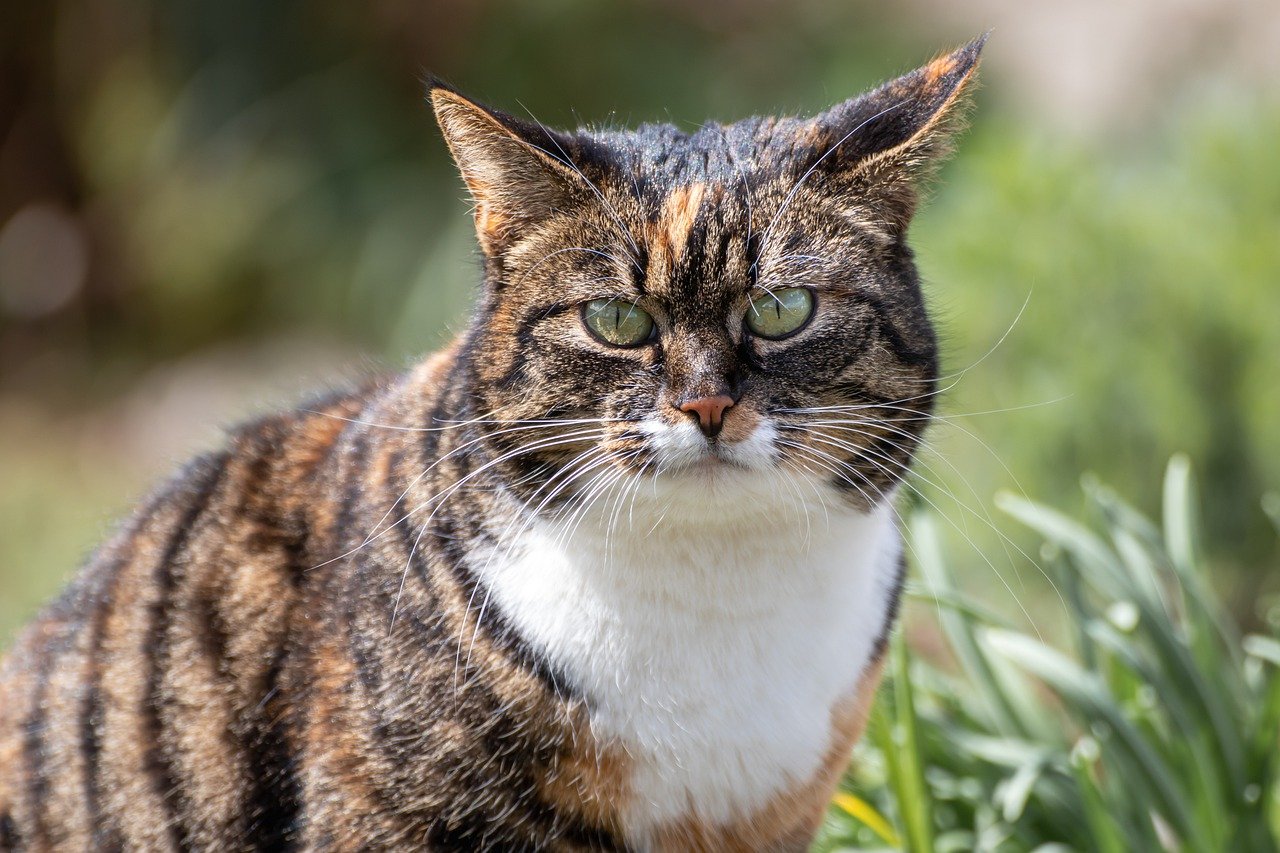
Positive Reinforcement Techniques
When it comes to grooming your cat, positive reinforcement is a game changer. Imagine trying to convince a toddler to eat their vegetables—bribing them with a cookie often does the trick! Similarly, using rewards during grooming can transform your cat's perception of the process from a dreaded chore to a fun bonding experience. By incorporating treats, praise, and playtime, you can create an atmosphere that encourages your feline friend to accept grooming with open paws.
One effective way to implement positive reinforcement is to use treats strategically. Think of treats as tiny tokens of appreciation for your cat's good behavior. When you start grooming, offer a treat immediately after your cat allows you to brush a small section of their coat. This immediate reward helps them associate grooming with something pleasurable. Over time, as your cat becomes more comfortable, you can gradually increase the duration of grooming while still providing treats. It’s essential, however, to time the treats correctly. For instance, if your cat is calm for a few moments, reward them right away, so they understand that their calm behavior is what earned them the treat.
In addition to treats, verbal praise can work wonders. Cats may not respond to compliments in the same way dogs do, but they certainly pick up on your tone of voice. Use a soft, cheerful voice to praise your cat during grooming sessions. Phrases like “Good kitty!” or “You’re doing so well!” can help reinforce a positive association with grooming. Pairing your praise with gentle strokes can make your cat feel safe and loved, further encouraging them to accept the process.
Creating a positive environment is another crucial aspect of positive reinforcement. Cats are sensitive creatures, and a calm atmosphere can significantly impact their grooming experience. Try to minimize distractions—turn off the TV, close the windows, and keep other pets away during grooming sessions. You might even consider playing soft music to help soothe your cat. A comfortable space where your cat feels secure will make them more willing to accept grooming.
As you progress with grooming, consider incorporating playtime as a reward. After a successful grooming session, engage your cat in their favorite game. This not only reinforces the idea that grooming leads to fun but also builds a stronger bond between you and your feline companion. Just like kids, cats love to play, and associating grooming with play can make them look forward to the next session.
In summary, positive reinforcement techniques are about creating a rewarding experience for your cat. By using treats, praise, and playtime, you can help your cat associate grooming with positive outcomes. Remember, patience is key—every cat is different, and it may take time for your furry friend to fully embrace grooming sessions. But with consistency and love, you’ll both enjoy the process!
- How often should I groom my cat? - It depends on the breed and coat type. Long-haired cats may need grooming several times a week, while short-haired cats may only require it once a month.
- What if my cat doesn't like being groomed? - Start slowly, use positive reinforcement, and ensure a calm environment. Gradually introduce grooming to help them adjust.
- Can I use human grooming tools on my cat? - It's best to use tools specifically designed for cats, as they are gentler on their skin and fur.
- What should I do if my cat shows signs of stress during grooming? - Stop the session immediately, give your cat some space, and try again later. Always monitor their comfort level.
Using Treats Effectively
When it comes to grooming your cat, can make a world of difference. Imagine this: You’re trying to get through a task that you find uncomfortable or even a bit scary. Now, what if someone offered you a delicious snack every time you faced that challenge? It would likely make the experience a lot more bearable, right? The same principle applies to our feline friends.
First off, it’s essential to choose the right type of treats. Cats can be picky, so finding something they absolutely adore is key. Whether it’s crunchy kibble, soft treats, or even a sprinkle of catnip, having a go-to reward can motivate your cat to stay calm during grooming sessions. You might want to create a grooming treat jar filled with their favorites. This can be a fun way to signal that grooming time is also treat time.
Timing is everything! When you start grooming, it’s crucial to offer treats at the right moments. For example, give your cat a treat immediately after they allow you to brush a section of their fur. This helps them associate grooming with something positive. You can even create a simple
| Session Number | Duration (minutes) | Treats Given | Cat's Reaction |
|---|---|---|---|
| 1 | 5 | 2 | Calm |
| 2 | 10 | 3 | Relaxed |
| 3 | 15 | 4 | Happy |
As you can see, tracking the duration and your cat's reactions can help you refine your approach. If you notice your cat becoming more comfortable over time, you can gradually increase the length of the grooming session. Just remember to keep those treats flowing!
Another effective strategy is to incorporate treats into the grooming process itself. For instance, you can hold a treat in your hand, allowing your cat to nibble on it while you gently brush them. This not only keeps their focus on the treat but also makes grooming feel less intimidating. Think of it as a little distraction technique that turns grooming into a bonding experience.
Lastly, don't forget the power of praise! Along with treats, verbal affirmations like “Good kitty!” or gentle petting can reinforce positive behavior. Your cat thrives on your approval, and combining treats with praise can create a delightful grooming atmosphere.
In conclusion, using treats effectively is all about timing, choice, and creating a positive association with grooming. By making grooming sessions enjoyable and rewarding, you’ll not only keep your cat looking fabulous but also strengthen the bond between you two. After all, a well-groomed cat is a happy cat!
- How often should I groom my cat? It depends on the breed and coat type, but generally, long-haired cats need grooming several times a week, while short-haired cats can be groomed once a week.
- What if my cat doesn't like treats? If your cat is not motivated by treats, try using their favorite toys or extra playtime as a reward instead.
- Can I use human food as treats? Some human foods are safe for cats, but always check with your vet before introducing new treats to ensure they are safe and healthy.
Creating a Positive Environment
Creating a positive environment for grooming your cat is essential to ensure that the experience is enjoyable for both you and your feline friend. Cats are sensitive creatures, and their surroundings significantly impact their mood and behavior. To start, choose a quiet and comfortable location where your cat feels safe. This could be a cozy corner of your living room or a designated grooming area that is free from distractions. The goal is to create a space that feels inviting and relaxing, so your cat can associate grooming with positive feelings.
Moreover, consider the temperature of the environment. Cats can be quite sensitive to temperature changes, so make sure the area is neither too hot nor too cold. A comfortable temperature can help your cat relax and be more receptive to grooming. Additionally, having their favorite blanket or a soft pillow can make the space even more appealing. You might be surprised at how much a little comfort can go a long way in easing your cat's anxiety.
Another crucial aspect is to minimize distractions. Turn off the TV, put away your phone, and keep other pets in another room if necessary. This focused attention not only helps your cat feel secure but also allows you to concentrate fully on the grooming process. You can even use calming music or soft sounds in the background to create a soothing atmosphere. Some pet owners find that playing gentle classical music can help calm their cats, making the grooming experience more pleasant.
It's also important to observe your cat's body language. If they seem tense or anxious, it may be time to take a break and try again later. Understanding their cues will help you adjust the environment and your approach accordingly. For instance, if your cat is fidgeting or trying to escape, it might be a sign that they need a little more comfort or that the grooming session is too intense. Always be prepared to adapt and make changes as needed.
Lastly, incorporating positive reinforcement into the grooming routine can further enhance the environment. After a successful grooming session, reward your cat with treats, praise, or playtime. This not only reinforces their good behavior but also helps them associate grooming with something enjoyable. Over time, your cat will likely begin to look forward to these sessions, transforming what was once a stressful experience into a bonding activity.
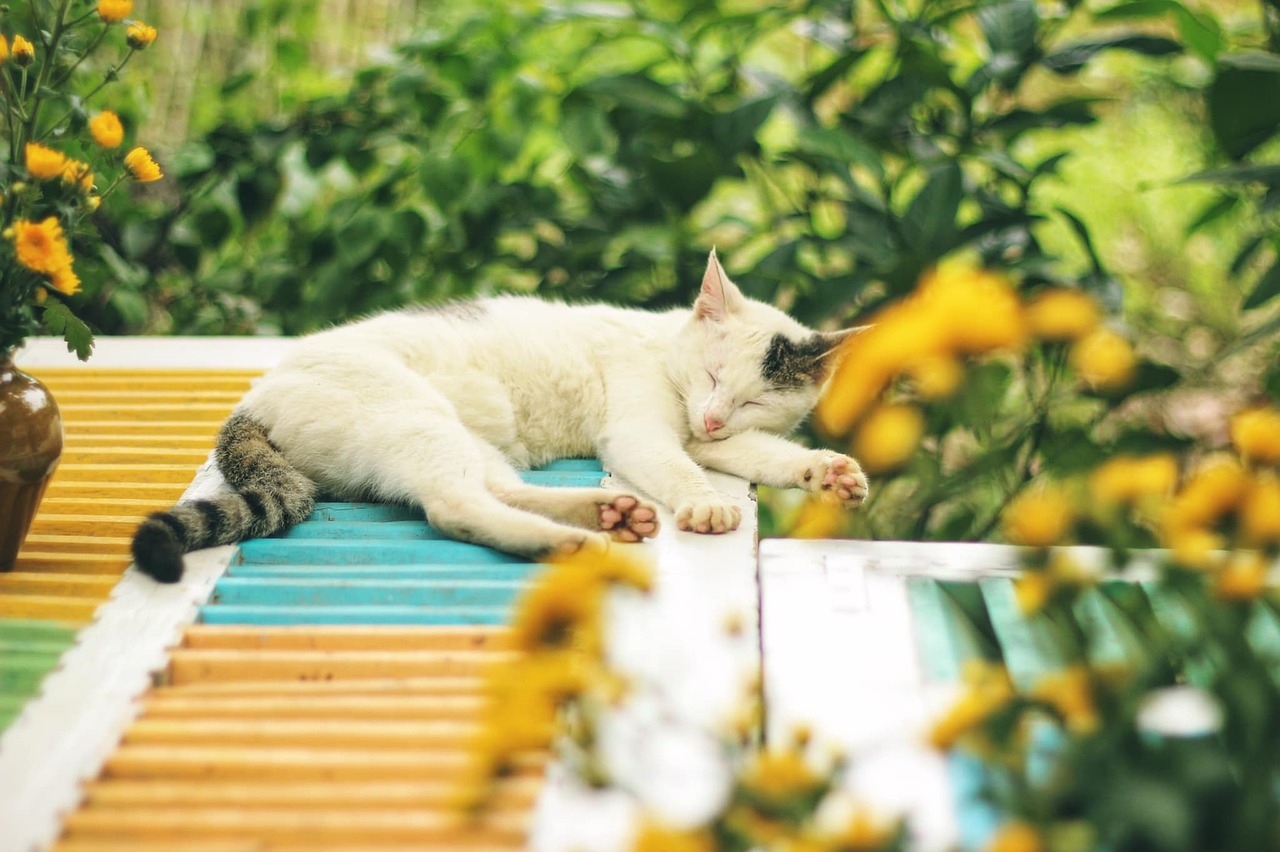
Monitoring Your Cat's Reaction
When it comes to grooming your cat, observing their reactions is absolutely essential. Every cat is unique, and their comfort levels can vary widely. As you embark on this grooming journey, keep in mind that your feline friend may not always express their feelings in ways that are easy to interpret. Therefore, it's crucial to be attentive and responsive to their body language and vocalizations. For instance, if your cat begins to squirm or pulls away, it might be a sign that they are feeling uncomfortable or stressed.
Understanding your cat's behavior can be the difference between a peaceful grooming session and a chaotic one. Some common signs to watch out for include:
- Purring: This often indicates that your cat is relaxed and enjoying the grooming.
- Hissing or growling: These are clear signs of distress and should prompt you to stop immediately.
- Twitching tail: A twitching tail can indicate agitation or annoyance, so be cautious.
- Flattened ears: If your cat's ears are pinned back, it’s a warning sign that they are not happy.
By carefully monitoring these signals, you can adjust your grooming techniques accordingly. If you notice that your cat is becoming anxious, consider taking a break or reducing the intensity of the grooming. Maybe switch to a gentler brush or even give them a little space before trying again. Remember, the goal is to make grooming a positive experience for both of you, so being flexible and patient is key.
Another effective strategy is to keep a grooming journal where you can jot down your cat’s reactions. This will help you identify patterns over time and fine-tune your approach. For example, if you notice that your cat tends to react positively to a specific brush or technique, you can prioritize that in future sessions. On the flip side, if a particular method consistently causes stress, it’s best to avoid it altogether.
Ultimately, the more you tune into your cat's reactions, the better you’ll become at making grooming a stress-free and enjoyable part of their routine. By fostering an atmosphere of trust and understanding, you’re not just grooming your cat; you’re also strengthening your bond with them.
Q: How can I tell if my cat is stressed during grooming?
A: Look for signs such as hissing, growling, flattened ears, or a twitching tail. If you notice any of these, it’s best to stop and give your cat a break.
Q: What should I do if my cat doesn't like being groomed?
A: Start with short sessions and gradually increase the duration as your cat becomes more comfortable. Use positive reinforcement, like treats and praise, to encourage them.
Q: How often should I groom my cat?
A: This depends on the breed and coat type. Long-haired cats may need grooming several times a week, while short-haired cats might only need it once a month.
Q: Can grooming help reduce shedding?
A: Yes! Regular grooming can help remove loose fur and reduce shedding, keeping your home cleaner and your cat's coat healthier.
Recognizing Signs of Stress
When it comes to grooming your cat, being able to recognize signs of stress is crucial. Cats are creatures of habit, and any disruption to their routine can lead to anxiety. You might be wondering, "How can I tell if my cat is stressed during grooming?" Well, there are a few key indicators to watch for that can help you gauge their comfort level.
First and foremost, pay attention to your cat's body language. A relaxed cat will have a loose body posture and may even purr during grooming. In contrast, a stressed cat might exhibit signs such as:
- Flattened Ears: If your cat's ears are pinned back against their head, it's a clear indication that they are feeling threatened or uncomfortable.
- Tail Position: A tail that is tucked between the legs or flicking back and forth rapidly can signal agitation.
- Hissing or Growling: Vocalizations like hissing or growling are unmistakable signs that your cat is not happy with the situation.
- Attempting to Escape: If your cat tries to jump off the table or squirm away from your grasp, it’s a clear sign that they want to leave the grooming session.
Additionally, you should keep an eye on their overall behavior. A cat that suddenly becomes overly aggressive or tries to bite may be feeling overwhelmed. It's essential to note that every cat is different, and some may show subtle signs of stress that can easily be overlooked. For instance, excessive grooming or licking can also indicate that your cat is trying to self-soothe in response to anxiety.
Understanding these signs allows you to adjust your grooming techniques accordingly. If you notice your cat exhibiting any of these stress indicators, it might be time to take a break. You can try soothing your cat with gentle strokes or calming words, or even take a short pause and resume grooming later when they seem more relaxed. Remember, the goal is to make grooming a positive experience for both you and your feline friend.
- How often should I groom my cat? The frequency of grooming depends on your cat's coat type. Long-haired cats may require grooming several times a week, while short-haired cats can be groomed less frequently.
- What should I do if my cat resists grooming? If your cat resists grooming, try to introduce the process gradually, using treats and positive reinforcement to make it a more enjoyable experience.
- Are there specific tools for anxious cats? Yes, there are grooming tools designed to be gentler on anxious cats, such as soft-bristle brushes and grooming gloves.
Adjusting Techniques as Needed
When it comes to grooming your cat, flexibility is key. Just like humans, cats have their own personalities and preferences, which means that what works for one cat might not work for another. **Being attentive to your cat's reactions** during grooming sessions can provide invaluable insights into how to adjust your techniques. For instance, if you notice your cat becoming restless or agitated, it might be time to switch up your approach.
One effective strategy is to **observe their body language** closely. If your feline friend is flattening their ears, twitching their tail, or trying to escape, these are clear signs that they are not comfortable. In such cases, you might want to take a step back and reassess. Perhaps you need to use a gentler touch or switch to a different grooming tool that feels more comfortable for them. Remember, grooming should be a **positive experience**, not a stressful one.
Here are some common adjustments you can make based on your cat's behavior:
- Change the Tool: If your cat seems to dislike a particular brush, try using a softer one or a deshedding tool instead.
- Modify the Technique: If your cat enjoys being petted but dislikes brushing, start with gentle strokes and gradually introduce the brush.
- Shorten Sessions: If your cat becomes anxious after a few minutes, shorten the grooming sessions and gradually increase the time as they become more comfortable.
Additionally, consider the environment in which you are grooming. **A calm and quiet space** can help your cat feel more at ease. If your cat is particularly skittish, you might want to play soft music or talk to them in a soothing voice. Creating a comforting atmosphere can significantly influence their comfort level during grooming.
Lastly, don’t forget to **check in** with your cat regularly. After each grooming session, take a moment to observe how they respond. If they seem more relaxed and even playful, you’re on the right track! On the other hand, if they continue to show signs of stress, it may be necessary to rethink your approach altogether. Remember, the goal is to build trust and make grooming a bonding experience, not a chore.
1. How often should I groom my cat?
The frequency of grooming depends on your cat's coat type. Long-haired cats may need grooming every day, while short-haired cats might only need it once a week.
2. What should I do if my cat bites or scratches during grooming?
If your cat becomes aggressive, stop the session immediately. Assess what might have triggered the behavior and consider adjusting your techniques or taking a break.
3. Can I use human grooming tools on my cat?
It's best to use grooming tools specifically designed for cats. Human tools may not be safe or effective for their fur and skin.
4. How can I calm my cat before grooming?
Try engaging in playtime or offering treats before grooming. This can help create a positive association with the grooming process.
Frequently Asked Questions
- How often should I groom my cat?
It really depends on your cat's coat type! Long-haired cats typically need grooming at least 2-3 times a week to prevent tangles and mats, while short-haired cats can usually get away with once a week. Regular grooming helps keep their coat healthy and reduces shedding, so find a routine that works for both of you!
- What if my cat hates being groomed?
Many cats are not fans of grooming at first, but with patience and the right approach, you can turn it into a positive experience. Start slowly, using gentle strokes and offering treats to reward good behavior. Gradually increase the time spent grooming as your cat becomes more comfortable.
- What tools are best for grooming my cat?
Choosing the right tools is essential! For most cats, a slicker brush works wonders for detangling and removing loose fur. If your cat has a longer coat, you might want to invest in a deshedding tool as well. Always consider your cat's specific needs when selecting grooming tools.
- Can I use human grooming tools on my cat?
It's best to avoid using human grooming tools on your cat. Cat grooming tools are specifically designed for their unique fur types and skin sensitivities. Using the wrong tools could cause discomfort or even injury, so stick with products made for felines!
- How can I tell if my cat is stressed during grooming?
Watch for signs like hissing, swatting, or trying to escape. If your cat is showing any of these behaviors, it might be time to take a break or adjust your approach. Pay attention to their body language, as a relaxed cat will have a loose body posture and may even purr!
- Is it okay to groom my cat while they are sleeping?
While it might seem convenient, grooming a sleeping cat can startle them and lead to a negative association with grooming. It's best to wait until they're awake and in a relaxed state. Choose a time when your cat is calm and comfortable for the best results!
- How do I create a positive environment for grooming?
Creating a calm and loving environment is key! Choose a quiet space free from distractions, and use soft voices and gentle touches. You can also play soft music to help soothe your cat. The more relaxed they feel, the more enjoyable grooming will be for both of you!

